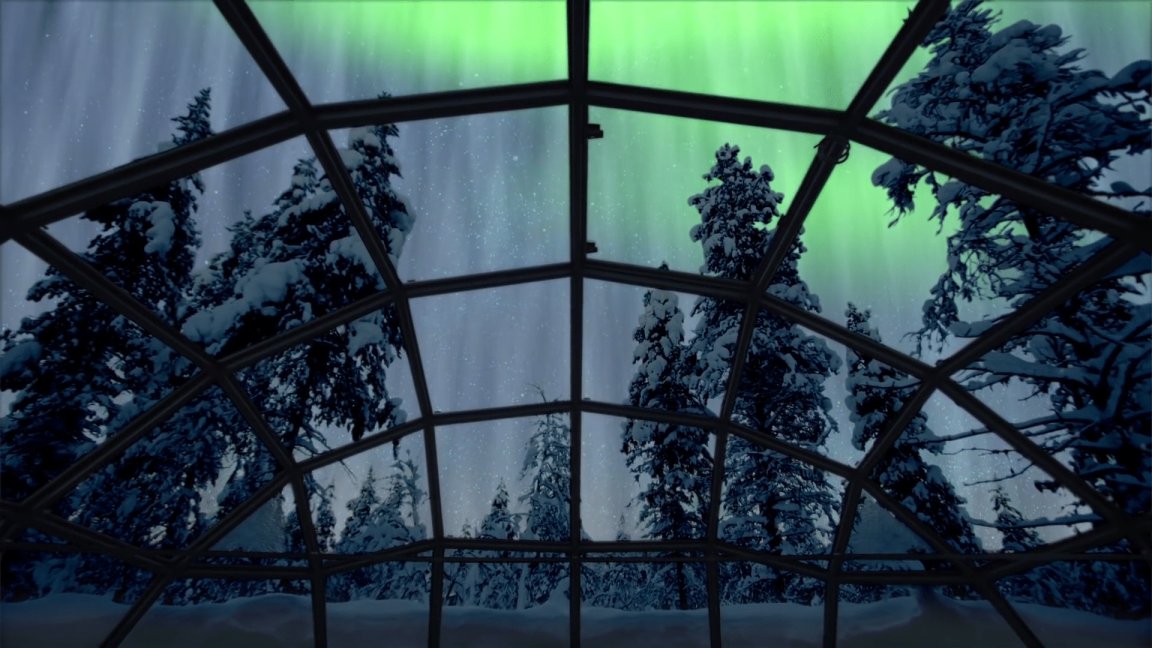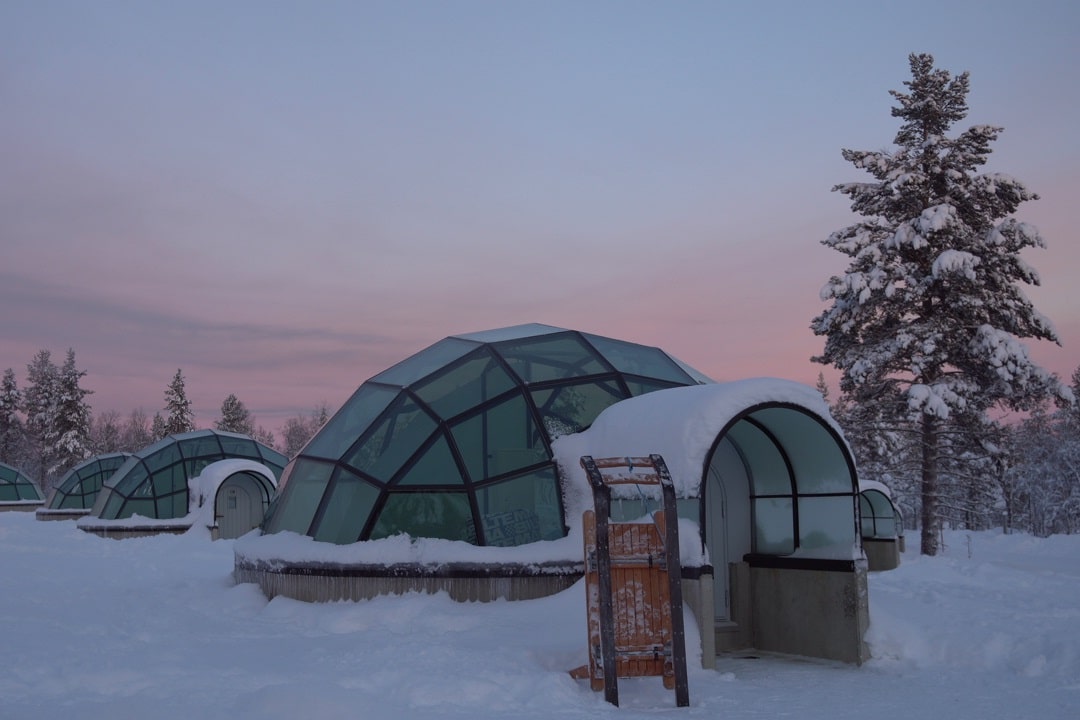
You don’t have to travel to the Arctic to disconnect, technically. If you’re strong of will, you could do it in your apartment. Even if you’re not, there is undoubtedly some corner of some state forest where you can ditch your cellular bars for a day or two.
But there’s also the Arctic.
The pitch was compelling—a week in a snow-covered cabin made of 400-year old pine logs, and a chance to see the aurora borealis through the panes of a tempered Glass Igloo at the resort that started it all. We booked our tickets the same day.
“Digital Detoxing” is a product of the connected generation. Across the world, access to the internet is increasingly being viewed as essential for quality of life. Back in December, Canada declared it a basic service that must be made available to all citizens. They will not be the last.
While it would be foolish to discourage its proliferation—the web has cultivated countless new industries, brought quality education to the ends of the Earth, and raised a generation of globally minded citizens—it would also be ignorant to suggest that its side effects aren’t worth addressing.
The average American now spends 30 percent of their leisure time browsing the internet—never mind those of us who spend our whole workday on a laptop as well. The average employee checks 40 websites per day, and changes tasks every two minutes. We also spend nearly two hours each day recovering from distractions.
Frenetic behavior like this takes a significant toll on us over time.
Studies have consistently linked heavy social media usage with depression. Similarly, exposure to artificial light—the kind emitted by our electronic devices—has proven to be detrimental to our natural sleep patterns. What’s more, the CDC now considers insufficient sleep to be an epidemic. And the list goes on.
It’s why millennials are flocking to expensive adult summer camps that promise opportunities to unplug (in many cases, they take your phone from you). It’s why remote retreats like Kakslauttanen Arctic Resort are beginning to host a younger crowd. And it’s why we decided to go experience it for ourselves.

Nearly every aspect of Kakslauttanen impedes digital connectivity. The renowned resort is located deep in Finnish Lapland—home to some 200,000 wild reindeer, and little else. In December, temperatures frequently dip below -30°C (-22°F). It is the kind of cold that renders text messaging fingers inanimate in a matter of seconds.
Inside, it doesn’t get much easier. By design there is no wi-fi or cable in the hotel’s sprawling collection of cabins, igloos, and kelo-igloos. “[The] fireplace is our television,” owner Jussi Eiramo told us during an interview. He isn’t joking.
By the end of your first day at Kakslauttanen, withdrawal sets in. Real withdrawal. By day two, however, you begin to sense a shift. When your phone is turned into a glorified alarm clock overnight, there is little reason to ever pick it up (outside of force of habit). There is so much more to do, anyway.
In early December, the sun rises above Lapland for just 15 minutes per day. The residual magic hour extends your time in the light by three or four hours, but the pervading experience is darkness. Fortunately, these are just the right conditions for Aurora Borealis—the Northern Lights shine for the better part of the year here.
They’re also just the right conditions to celebrate (and practice) the naturalist lifestyle of the Finns, which has been proven to be incredibly healthy. Finnish sauna has been linked to longer life and fewer fatal heart problems. The cold weather characteristic of Lapland has been linked to better sleep and an improved metabolism.
Kakslauttanen has engineered the whole resort to empower guests to experience the auroras both comfortably and adventurously (the choice is yours). Jussi and team were among the first to build Glass Igloos in Lapland, and they’re still busily innovating year over year. Consider them “Northern Lights Lite.”
The local reindeer, who winter in the resort, allow you to experience the lights deep in the forest from the cold comfort of a wooden sled. Consider them “Northern Lights Advanced.” Soon, an in-progress Glass Igloo Tower will allow guests to get closer than ever to the action. In short, there are no excuses for missing the greatest show on Earth.
[html5_video src=”https://futurism.com/wp-content/uploads/2017/01/InlineVideo2.mp4″][/html5_video]
While you’re waiting for the auroras to take over the sky, there is plenty else to keep you occupied: snow mobile trekking, husky dog sledding, cross-country skiing, horseback riding, and ice fishing. There’s a traditional Finnish smoke sauna, too, if sweating it out is your thing.
That’s not to say you’ll want to book yourself solid, of course. The daily rhythms of relaxation at Kakslauttanen are key to the detoxing experience.
It goes a little something like this:
08.30 I wake up in my cabin and begin collecting my layers—long johns, jeans, snow pants, wool socks, winter boots, long sleeve thermal, fleece, jacket, earmuffs, hat, gloves. It probably won’t be enough.
09.00 I brace for the cold and step outside. The resort’s restaurant is just a few hundred yards away, but the way is treacherously cold—35 below zero, and still falling somehow.
09.05 I arrive at the restaurant and begin curating the usual breakfast—greek yogurt, Lapland berries, toasted bread, cold cuts, cheese. coffee (x3).
09.45 The sun rises.
09.57 The sun sets.
10.00 I head out for the morning’s activity—a 4-hour snowmobile trek through pristine Finnish forestland.
14.00 I return to the restaurant for lunch—a veritable buffet of traditional and international soups. The thawing process begins.
15.00 I disappear into my cabin’s personal sauna, where I’ll remain until all the snow and ice has turned to sweat.
17.45 I restart the long process of layering, changing nothing but my socks. I should have brought more wool.
17.58 I glance at the clock on my phone, then set it back down.
18.00 I brace for the cold and step outside, delighted to find that the temperature has risen to a balmy 25 below. I head to the restaurant once again.
18.05 I order the dinner selection of the day—smoked reindeer, smashed potatoes, and local vegetables, with a berry compote for dessert.
20.00 I head out for the evening’s activity—a reindeer-led sledding expedition to hunt aurora borealis.
20.13 The aurora begins. Our eyes are glued to the sky as the lights dance around us. Even the reindeer seem to take notice.
20.45 We arrive at a lonely canvas tepee in the deep of the forest, where a fire and hot tea have been prepared for us.
21.30 We return, half frozen, to Kakslauttanen.
22.00 I drop by the igloo bar for a few drinks before turning in for the night.
23.00 I return to my cabin, and prepare to do it all again tomorrow.

It’s a strange thing to find pride in—spending a few hours, or a week (in our case), without your phone. The feeling is doubtlessly and distinctly millennial, a product of a generation whose livelihoods are dependent on connectivity. As I ponder the week’s juxtapositions, I recall an anecdote Jussi told me during an early conversation about his creation.
“Evenings, when the people come to dinner here, don’t speak nothing with company, or with friends. Only with computer. This is normal today. I think in future, people wake up. This is not all life. Here, you can find life without computer.”
He’s got a point, of course, but I don’t think we’re meant to reject technology completely. For all its flaws and harmful side effects, the web has done immeasurable good for humanity, and we are just getting started. At the same time, it should be used as a reference guide to life, not a replacement for it.
The 45-second Facebook videos that show us the depths and dynamism of our world—the ones that led us to Kakslauttanen in the first place—are meant to inspire us to start packing, not keep scrolling. When you finally arrive, you’ll find there’s no reason to look to your newsfeed for beauty, because it is all around you.
If you’re lucky, the lesson is one you’ll bring back home.
[html5_video src=”https://futurism.com/wp-content/uploads/2017/02/InlineVideo3.mp4″][/html5_video]
Disclosure: Kakslauttanen paid for Futurism’s travel and lodging expenses.